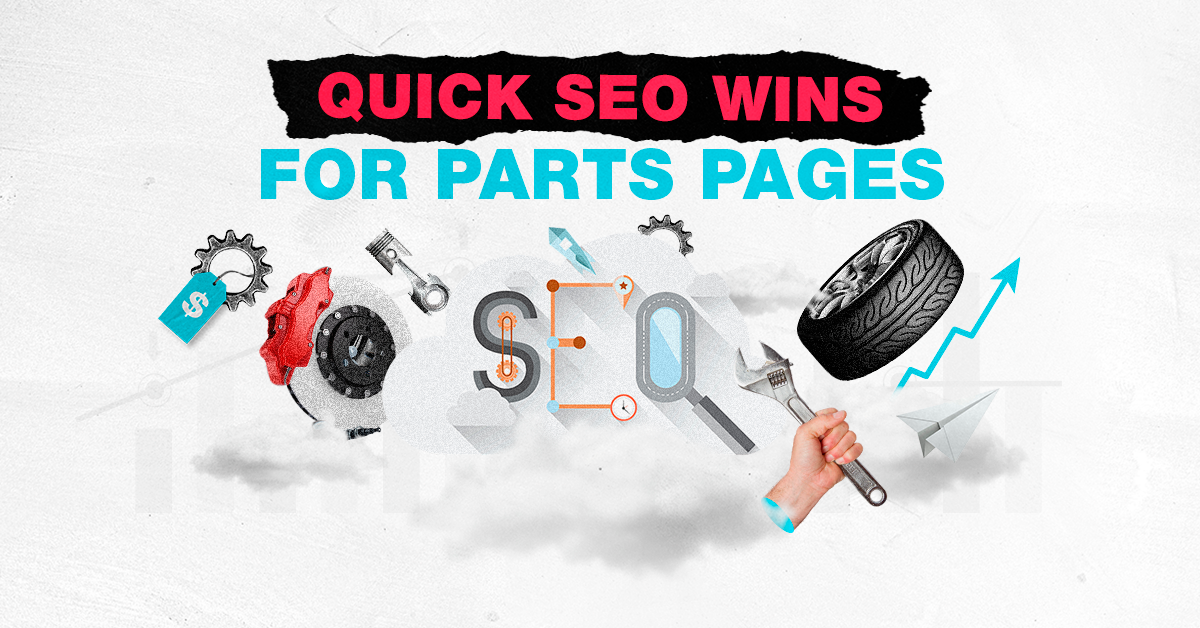
After working with hundreds of auto parts e-commerce clients at Scube Marketing, I've seen the same story play out countless times: brilliant business owners who know everything about torque specs and part compatibility, but struggle to get their products visible on Google. You're not alone if you've felt frustrated watching major retailers dominate search results while your carefully curated inventory gets buried on page five.
The automotive aftermarket is a unique beast when it comes to SEO. Unlike selling generic consumer goods, you're dealing with complex fitment data, cross-reference numbers, and customers who search in six different ways for the same brake pad. Building a keyword list should start with topics relevant to your inventory and customer needs—organizing keywords by topic helps manage large inventories and ensures complete coverage (Source: Hedges & Company). This isn't just about stuffing keywords into your pages; it's about understanding how car enthusiasts and professional mechanics actually search for parts.
This checklist will walk you through the specific on-page optimization strategies that move the needle for auto parts businesses. We'll cover everything from mastering the art of fitment-based keywords to implementing schema markup that makes Google love your product pages. By the end of this guide, you'll have a clear roadmap to optimize both your category and product pages for better rankings and more qualified traffic.
Here's what most auto parts business owners get wrong about keyword research: they think like parts guys, not like their customers. When I analyze search data for automotive clients, I consistently find that shoppers use six main search patterns that you need to optimize for. Automotive shoppers use six main search patterns:
Each often modified by vehicle fitment like year/make/model (Source: Hedges Company).
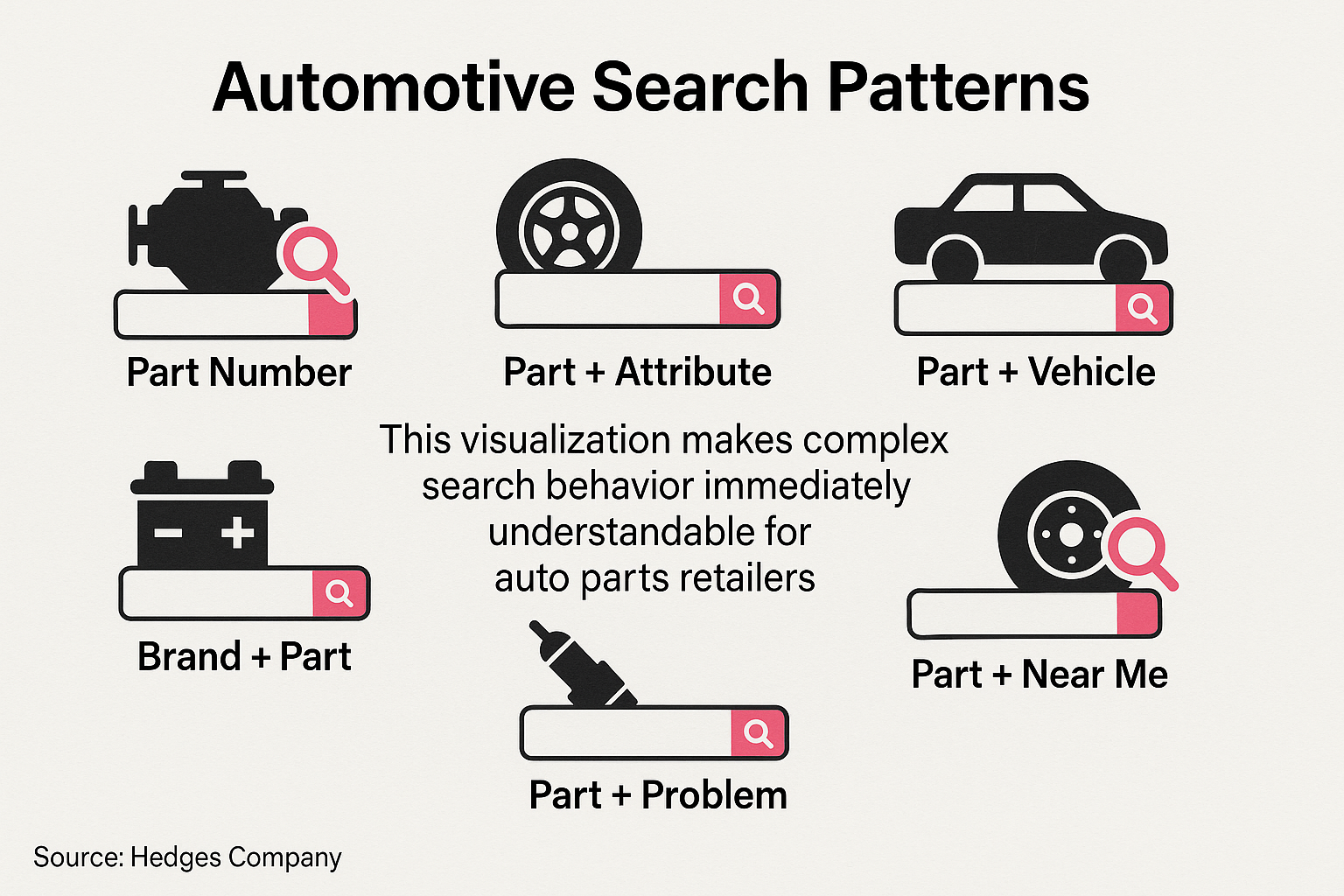
The magic happens when you understand that each search pattern requires different optimization approaches. A customer searching for "brake pads" has completely different intent than someone searching "D1092-7987A cross reference." The first person is browsing and comparing options; the second person knows exactly what they need and just wants to find it quickly. Long-tail keywords reflecting buyer intent (like "2015 Ford F150 brake pads") are crucial due to the specificity of auto parts shopping behavior (Source: Vocal Media).

|
Search Pattern
|
Example Query
|
Optimization Focus
|
|---|---|---|
|
Fitment-Based
|
"2018 Honda Civic oil filter"
|
Year/Make/Model in titles and headers
|
|
Part Number
|
"OEM 15400-RTA-003"
|
OEM numbers and cross-references
|
|
Symptom-Driven
|
"squeaking brake pads Honda"
|
Problem-solution content
|
|
Brand-Specific
|
"Bosch air filters Toyota"
|
Brand + fitment combinations
|
When working on automotive product listing optimization, I always start by building topic clusters around these search patterns. You can't just throw keywords at the wall and hope something sticks—you need a systematic approach that covers all the ways your customers might discover your products.
The foundation of any successful auto parts page starts with getting your basic on-page elements right. Think of these elements as the nuts and bolts that hold your SEO strategy together. Page titles must be descriptive, include the main keyword (such as part name or number), and remain under 60 characters for optimal display in search results (Source: Attrock). This might seem restrictive when you're dealing with long part names and fitment data, but it forces you to prioritize what matters most to searchers.
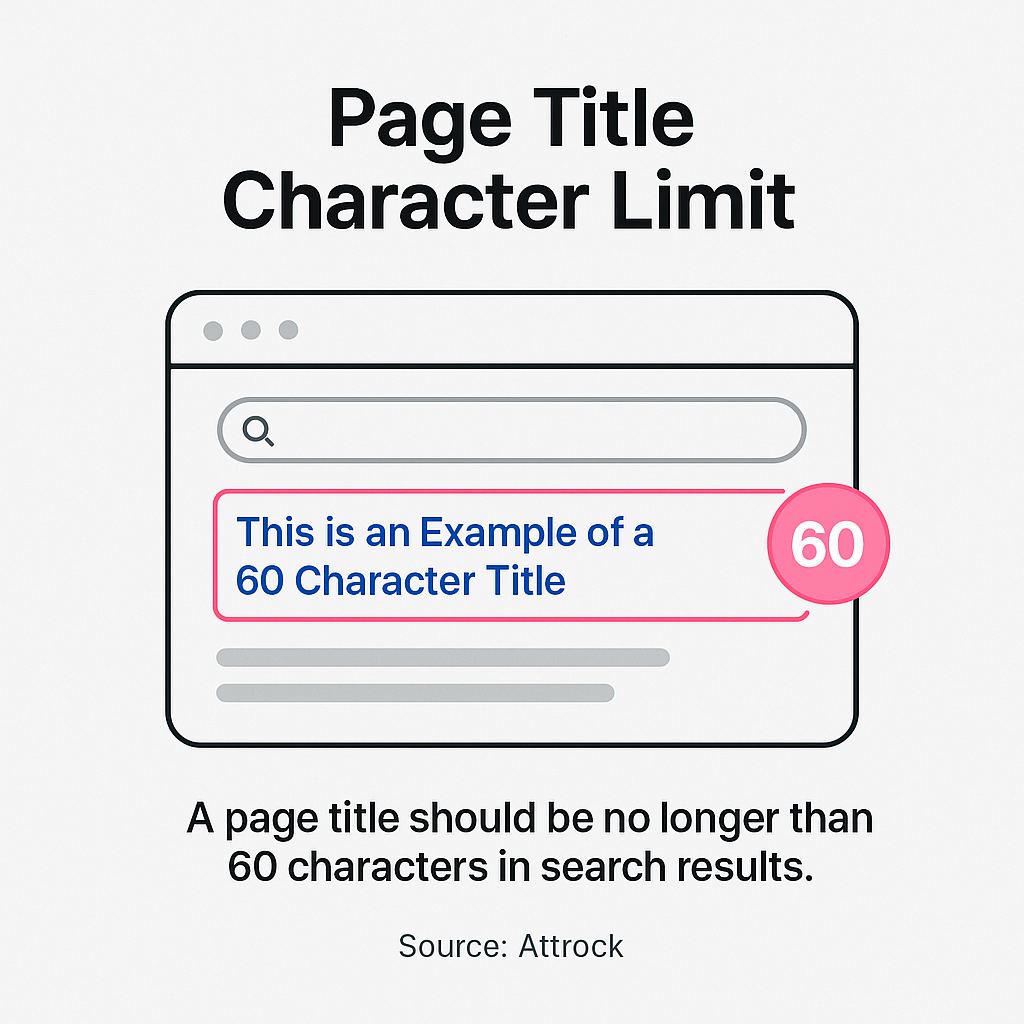
Your meta descriptions don't directly impact rankings, but they're your sales pitch in the search results. Meta descriptions should summarize page content compellingly to improve click-through rates, even though they don't directly impact rankings (Source: Attrock). I've seen click-through rates improve by 40% just by rewriting meta descriptions to include specific fitment information and benefit-focused language that speaks to the searcher's intent.
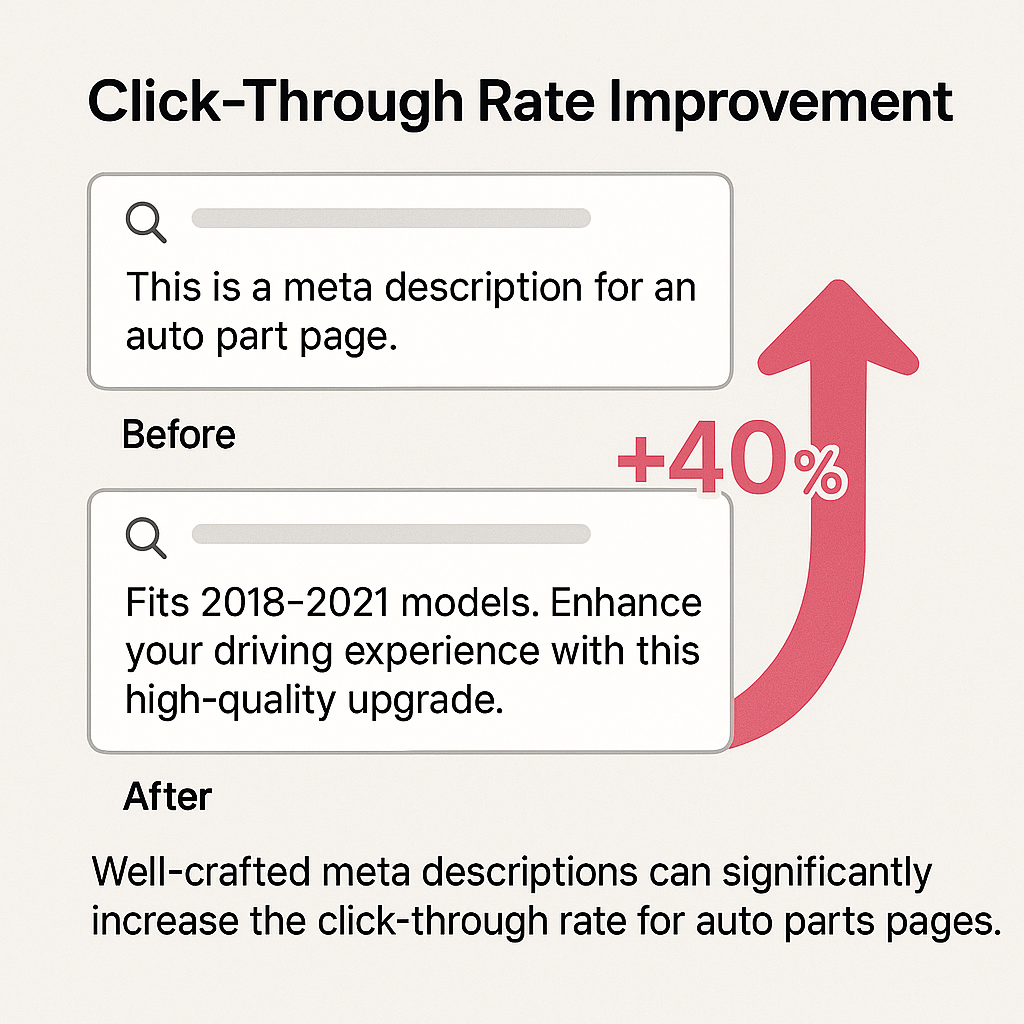
Header tags are where you can really show Google what your page is about. H1 tags need to clearly state the product or category focus using primary keywords; subheadings (H2/H3) help structure compatibility details or unique selling points (Source: Attrock). Don't waste your H1 tag on generic phrases like "Quality Auto Parts"—be specific about what you're selling and who it fits.
|
Element
|
Character Limit
|
Best Practice Example
|
|---|---|---|
|
Title Tag
|
60 characters
|
"Brake Pads for 2015-2020 Ford F150 | Premium Quality"
|
|
Meta Description
|
160 characters
|
"Shop premium brake pads designed for 2015-2020 Ford F150. OEM quality, easy installation. Free shipping on orders over $75."
|
|
H1 Tag
|
No limit
|
"Brake Pads Compatible with Ford F150 (2015-2020)"
|
URL structure is another critical element that many auto parts sites mess up. Use clean, keyword-friendly URLs that reflect both product/category names and key attributes such as fitment ("/brake-pads/ford-f150/2015") (Source: Attrock). Avoid URLs filled with product codes that mean nothing to search engines or users—make them readable and logical.
Product pages are where the rubber meets the road in auto parts SEO. These pages need to serve two masters: search engines that want detailed, relevant information, and customers who need to verify compatibility before they buy. The trick is balancing these needs without creating pages that feel like they were written by robots for robots.
Include detailed compatibility information on each product page—year/make/model/engine—to capture long-tail "fitment" queries that drive high-conversion traffic in auto parts e-commerce (Source: Hedges Company). This isn't just about listing every compatible vehicle; it's about organizing this information in a way that both search engines and customers can easily digest. I recommend using structured lists or tables for compatibility data, making it scannable for users while providing clear signals to search engines.
Your product descriptions need to go beyond basic specifications. When crafting high-converting auto parts product descriptions, focus on addressing the specific concerns and questions your customers have. Professional mechanics care about different details than weekend DIY enthusiasts, so tailor your content accordingly.
Don't forget about the technical SEO aspects that support your content. Understanding MPN numbers and their importance for ecommerce listings helps you implement proper structured data that can lead to rich snippets in search results.
Category pages often get treated as afterthoughts, but they're actually some of your most valuable SEO real estate. These pages need to target broader search terms while still providing specific value to visitors. The key is creating category pages that serve as useful hubs rather than just product dumps.
Category pages should target broad but specific queries (like "Honda Accord air filters"), include introductory content describing selection criteria or top brands carried, and offer faceted navigation so users can filter results efficiently. Think of your category page as the knowledgeable sales associate who can guide customers to exactly what they need without overwhelming them with choices.
|
Page Element
|
Optimization Strategy
|
Example Implementation
|
|---|---|---|
|
Category Title
|
Include primary keyword + broad fitment
|
"Brake Pads for Ford F150 (2015-2020)"
|
|
Intro Content
|
200-300 words explaining category benefits
|
Overview of brake pad types, materials, brands
|
|
Faceted Navigation
|
Allow filtering by key attributes
|
Year, Make, Model, Brand, Price Range
|
|
Product Sorting
|
Default to most relevant or popular
|
Best Sellers, Price Low to High, Newest
|
The introductory content on category pages serves multiple purposes. It provides context for search engines about what the page covers, helps customers understand their options, and creates opportunities to target related keywords naturally. Keep this content focused on helping customers make decisions rather than just filling space with keyword-stuffed paragraphs.
Your automotive catalog structure should guide how you organize these category pages, creating logical hierarchies that both users and search engines can follow easily.
Managing SEO for thousands of auto parts presents unique challenges that don't exist in other ecommerce verticals. You might have 50 different air filters that are essentially the same product with different fitments, or hundreds of brake pads that differ only in minor specifications. The key is creating a technical SEO framework that can scale without creating duplicate content issues.
Internal linking is essential: link related products (such as compatible parts) and categories to distribute ranking power across your site while aiding navigation for users managing complex catalogs (Source: Attrock). This isn't just about SEO—it's about helping customers discover complementary products they might need for their project. When someone buys brake pads, they might also need brake fluid, rotors, or installation hardware.
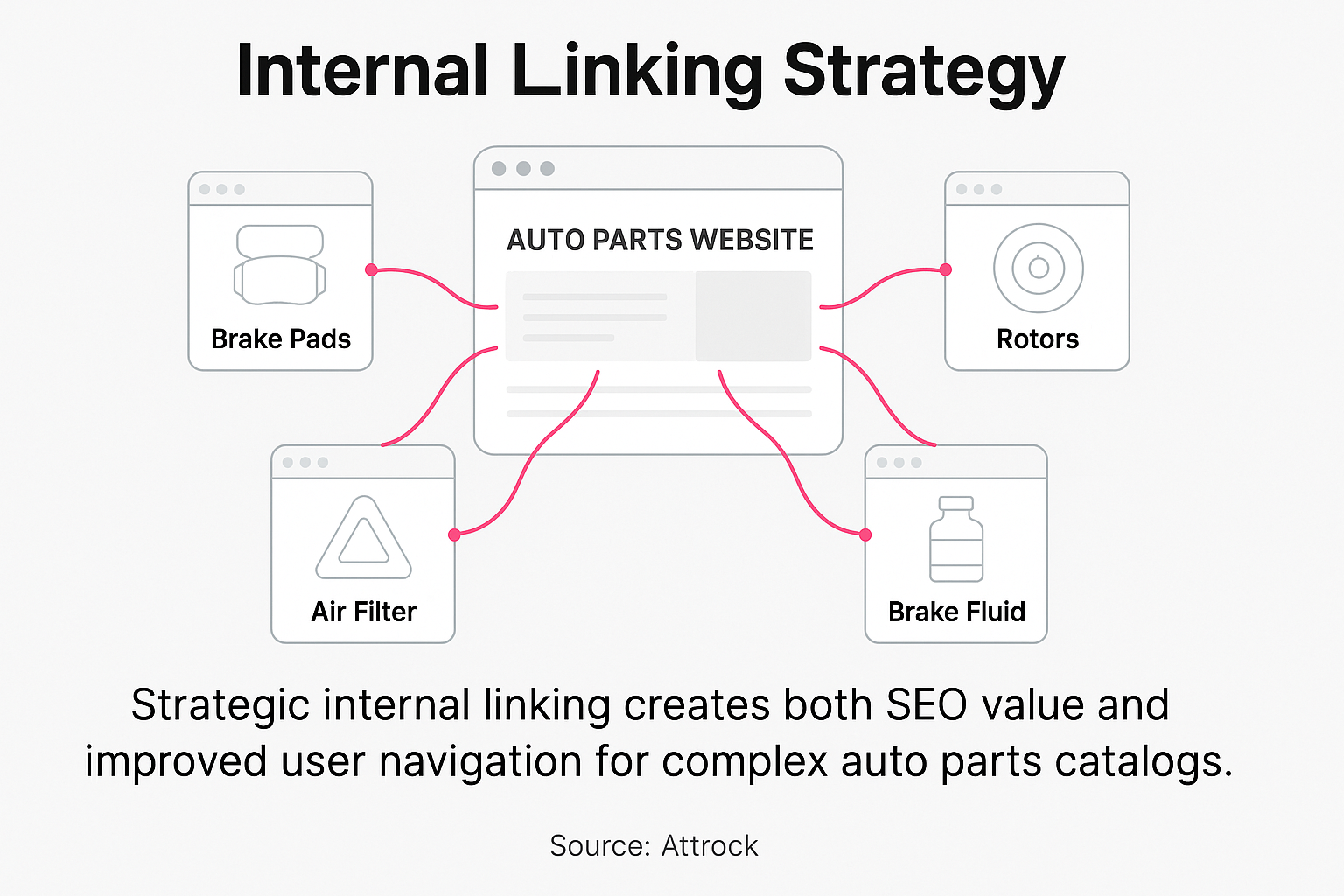
For sites with thousands of SKUs, dynamic tagging becomes crucial. Use dynamic meta tags that automatically populate based on database fields such as make/model/year/application. This approach lets you create unique, relevant titles and descriptions for every product page without manually writing thousands of meta tags. Just make sure your dynamic templates create genuinely useful titles rather than keyword-stuffed monstrosities.
|
Technical Challenge
|
Solution Strategy
|
Implementation Tips
|
|---|---|---|
|
Duplicate Content
|
Canonical tags for similar products
|
Point variations to main product page
|
|
Large Inventory Management
|
Dynamic meta tag templates
|
Use database fields for auto-population
|
|
Site Architecture
|
Logical category hierarchy
|
Make > Model > Year > Part Type
|
|
Page Speed
|
Optimize images and database queries
|
Compress images, efficient filtering
|
Canonical tags become your best friend when dealing with similar products. Ensure canonical tags prevent duplicate content from similar products differing only by minor attributes. This is especially important for parts that might fit multiple years of the same vehicle or have slight variations that don't warrant separate pages.
Understanding automotive feed management helps ensure your product data stays organized and your technical SEO implementations remain consistent across your entire inventory.
Schema markup is like giving Google a detailed parts catalog for your website—it helps search engines understand exactly what you're selling and can lead to rich snippets that make your listings stand out in search results. For auto parts, proper schema implementation can mean the difference between a boring text listing and a rich result that shows ratings, availability, and pricing.
Implement structured data using schema.org/Product markup, including properties like brand, model number/SKU/OEM number, and add AggregateRating if reviews are present. This enhances eligibility for rich snippets in Google's results. The key is being thorough but accurate—don't markup information you don't actually display on the page.
The automotive industry has some specific schema considerations that other ecommerce sites don't face. Vehicle compatibility information, OEM part numbers, and fitment data all can be included in your structured data to provide search engines with detailed product information that helps with relevancy matching.
Auto parts customers often shop in unique circumstances—they might be in a parking lot with a broken-down car, in their garage comparing part numbers, or at a parts store double-checking compatibility. This means your mobile optimization needs go beyond just making things look good on small screens.
Auto parts buyers expect fast load times—even a one-second delay can reduce conversions significantly—and mobile-friendly layouts since many shop via smartphone while working near their vehicles. When someone's car won't start and they need parts fast, a slow-loading mobile site becomes a major barrier to conversion.
Mobile optimization for auto parts sites needs to prioritize key information above the fold. Make sure fitment information, part numbers, and pricing are immediately visible without scrolling. Clear calls-to-action like "Check Fitment" or "Add Vehicle" help guide buyers through complex decision-making processes typical in automotive ecommerce.
|
Mobile Element
|
Auto Parts Specific Needs
|
Optimization Priority
|
|---|---|---|
|
Page Speed
|
Users often on cellular data
|
Compress images, minimize scripts
|
|
Touch Targets
|
May be wearing gloves while shopping
|
Larger buttons, spaced appropriately
|
|
Information Hierarchy
|
Compatibility is critical information
|
Fitment data above the fold
|
|
Search Functionality
|
Part number searches common
|
Prominent search with auto-suggestions
|
The importance of mobile optimization for automotive conversion strategies cannot be overstated. When someone needs parts urgently, your mobile experience often determines whether they buy from you or drive to the nearest auto parts store instead.
Tracking SEO success for auto parts sites requires looking at metrics beyond basic rankings and traffic. You need to understand which types of searches drive the most valuable traffic and how different customer segments interact with your optimized pages. Are weekend DIYers finding your content helpful? Are professional mechanics completing purchases after finding exactly the part numbers they need?
Focus on tracking keyword performance across all six search patterns we discussed earlier. Monitor how fitment-based searches perform compared to part number searches, and pay attention to which types of queries lead to actual conversions rather than just traffic. This data helps you prioritize your optimization efforts on the search patterns that matter most to your business.
Set up tracking for important user actions like using your vehicle selector tool, downloading installation guides, or viewing compatibility information. These micro-conversions often predict purchase behavior better than simple pageviews and help you optimize the complete customer journey.
For broader SEO strategy insights, understanding SEO approaches for aftermarket parts growth can help you see how your on-page optimization efforts fit into your overall digital marketing strategy.
After auditing hundreds of auto parts websites, I've noticed the same mistakes appear repeatedly. The biggest one? Treating every page like it needs to rank for every possible keyword. This leads to keyword cannibalization where multiple pages compete against each other instead of working together to dominate search results for your brand.
Another common mistake is ignoring the unique search behavior of different customer types. A professional mechanic searching for "brake pads" has completely different needs than a car owner looking for the same thing. Your pages need to address these different search intents appropriately rather than trying to be everything to everyone.
The most successful auto parts sites focus on being incredibly helpful for specific use cases rather than trying to rank for every automotive-related term. Build authority in your specialty areas first, then expand to adjacent topics and product categories.

Implementation is where most SEO strategies fall apart. You can have the perfect checklist, but without a systematic approach to rolling out these changes, nothing happens. Start with your highest-traffic pages and most important product categories. Don't try to optimize everything at once—that's a recipe for burning out your team and diluting your efforts.
Create a spreadsheet tracking your optimization progress across different page types. Include columns for current performance, optimization status, and results after changes. This data becomes invaluable for understanding which optimizations drive the biggest improvements for your specific business.
Test your changes on a small subset of pages first. Auto parts SEO can be unpredictable because of the complex interplay between search intent, competition levels, and seasonal demand patterns. What works for brake pads might not work for air filters, so gather data before rolling out changes site-wide.
|
Priority Level
|
Focus Areas
|
Expected Timeline
|
|---|---|---|
|
High Priority
|
Top 20 product pages, main categories
|
2-4 weeks
|
|
Medium Priority
|
Secondary categories, brand pages
|
1-2 months
|
|
Low Priority
|
Long-tail product variations
|
Ongoing maintenance
|
The goal isn't perfection on day one—it's consistent improvement over time. SEO success in the auto parts industry comes from understanding your customers deeply and optimizing your pages to match how they actually search for and evaluate products. Stay focused on providing genuine value, and the rankings will follow.
Our customers value boutique agency approach with access to a seasoned team, profit-based goals, and clear communication.



